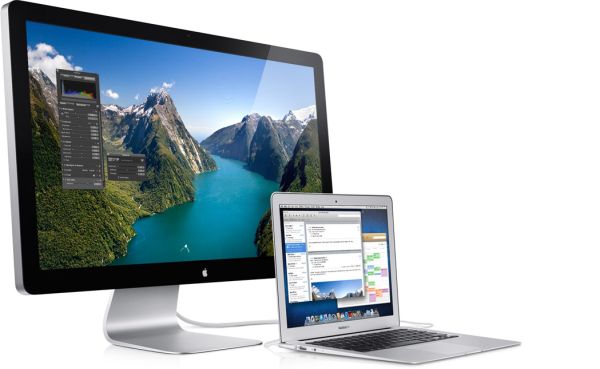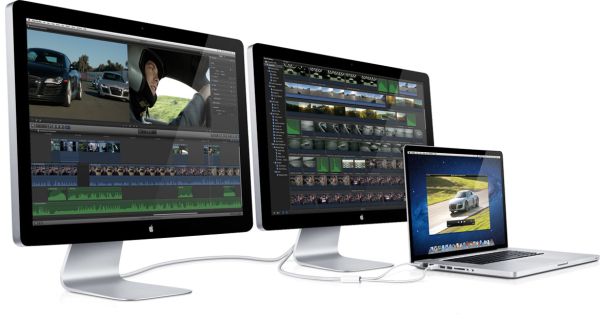Apple Updates Cinema Display, It's a Thunderbolt Display Now
by Kristian Vättö on July 20, 2011 12:25 PM EST- Posted in
- Apple
- Mac
- Cinema Display
- Thunderbolt
- Thunderbolt Display
Along with today’s MacBook Air and Mac mini updates, Apple has also updated their 27” Cinema Display. The display now goes by a new name: the Apple Thunderbolt Display (ATD). As the name implies, the display now features Intel’s new Thunderbolt interface, which Apple has heavily adopted in all new 2011 Macs. The ATD is world’s first commercially available Thunderbolt display and the second Thunderbolt device, the first one being Promise’s Pegasus enclosure.

Lets go through the specifications now:
| Apple Thunderbolt Display Specifications | |
| Screen size | 27" |
| Resolution | 2560x1440 |
| Panel type | In-plane switching (IPS) |
| Brightness | 375 cd/m2 |
| Viewing angles | 178°/178° |
| Contrast ratio | 1000:1 |
| Response time | 12ms |
| Cables (built-in) | Thunderbolt, MagSafe |
| Ports | 3x USB 2.0, FireWire 800, Gigabit Ethernet, Thunderbolt |
| Video and audio | FaceTime HD camera with mic, 2.1 speaker system |
| Dimensions (WxDxH) | 25.7" x 8.15" x 19.35" |
| Weight | 23.5lb |
| Price | $999 |
Essentially, the ATD is just a 27” Cinema Display with Thunderbolt. The screen size is the same, the resolution is the same, and I wouldn’t be surprised if the panel was exactly the same as well. From outside, you can’t see any difference, sans the extra ports. The dimensions are a match. Even the price stays at $999.
The difference comes when we talk about Thunderbolt and what it brings. The Cinema Display had three cables: Mini DisplayPort, MagSafe (power) and USB 2.0. Thanks to Thunderbolt, mDP and USB 2.0 have been merged into one and there are now only two cables: MagSafe and Thunderbolt.
Laptop-as-a-desktop users rejoice, the Thunderbolt Display features FireWire 800, USB 2.0 and Gigabit Ethernet - all of which are carried over the single Thunderbolt cable. There is also a second Thunderbolt port for daisy-chaining. As Thunderbolt provides up to 10Gb/s per channel, it’s more than adequate for 2560x1440 display and an external RAID box as we mentioned in our Promise Pegasus R6 & Mac Thunderbolt Review.
Example of daisy-chaning
Apple's Thunderbolt Display really shows us the potential of Thunderbolt by integrating many different interface standards into a single cable. Honestly the only thing that's missing is audio-out on the Thunderbolt Display itself for users who prefer external speakers.
The biggest, and possibly the only, issue here is USB 2.0 - it feels so outdated considering that nearly all PCs have USB 3.0 now. We probably won't see USB 3.0 support from Apple until Ivy Bridge brings it natively in 2012. However, even with only USB 2.0, the ATD is a great option for the owners of 2011 Macs with Thunderbolt. Apple will continue to sell the existing 27-inch Cinema Display as the new Thunderbolt Display will not work with machines that don't support Thunderbolt.
The Apple Thunderbolt Display is available from Apple's Online Store with an estimated shipping time of 6-8 weeks.











82 Comments
View All Comments
TEAMSWITCHER - Thursday, July 21, 2011 - link
Proprietary docking ports have always been mechanically complex and made laptop computers thicker than they need to be. Thunderbolt is a universal high speed interface optimized for performance oriented portable devices. With Thunderbolt, Dell would no longer need to be in the docking station business. I'm sure they don't make enough money selling docking stations to justify the development costs. Thunderbolt is a great idea, Dell would be stupid not to include it on their high end laptops. And my point is that Dell will be stupid.bigboxes - Thursday, July 21, 2011 - link
Thunderbolt is only universal if everyone adopts it. Until then it's just an overpriced proprietary standard.designerfx - Wednesday, July 20, 2011 - link
every part of that is called "Apple by definition"including the "not compatible and basically useless".
diamondsw2 - Wednesday, July 20, 2011 - link
USB wasn't compatible with serial, PS/2, etc. SATA wasn't compatible with IDE. PCI wasn't compatible with ISA.Meanwhile, USB 3.0, eSATA, and others are far more limited, and not just in bandwidth. Sure, they're okay for hooking up a hard drive - but you just can't do things like this.
steven75 - Friday, July 22, 2011 - link
Apple was the first to widely deploy USB. Your argument is invalid.repoman27 - Wednesday, July 20, 2011 - link
It is backwards compatible, with DisplayPort. Every computer made to date that includes Thunderbolt also has USB 2.0, so they are all just as backwards compatible as any machine with USB 3.0. Thunderbolt is an external interface for carrying DisplayPort and PCIe packets, which makes it very flexible, and does not require the creation of new custom drivers for existing technologies based on those very common standards.USB 3.0 currently requires a custom chip. It is incapable of ever carrying a digital display signal. It is a shared bus based on a tiered star topology, so the protocol overhead is horrendous. The physical layer is a complete kludge. In a best case scenario, it offers about 15% of the usable bandwidth of a Thunderbolt link.
And I'm sure the list of USB 3.0 devices you currently own is a mile long.
xrodney - Thursday, July 21, 2011 - link
Carrying full HD uncompressed video signal over USB 3.0 was demonstrated over year ago even before Intel even mentioned his Thunderbolt.USB 3.0 offers 5 Gbit/s when Thunderbolt can use 20 which doesn't make it 15% as you suggest but 25% still offer offer enough bandwidth for full HD video stream at small fraction of cost.
repoman27 - Thursday, July 21, 2011 - link
Full HD... as in 1920x1080... High end displays such as the ATD are 2560x1440. Even at 24 bpp, 60 Hz, using CVT-R, driving one of these displays requires at least 5,800,780,800 bps of actual throughput. Now try to connect two of them, along with additional channels for audio and USB.USB has been marketed by a consortium that has put a lot of effort into misleading the public with big numbers, much like WiFi (n 450 anyone?). The overhead associated with the USB protocol causes the actual bandwidth to be far less than the nominal signaling rate of 5 Gbps. 8b / 10b encoding brings it down to 4 Gbps right off the bat. Link flow control, packet framing and other protocol overhead will knock it down further until you're under 3.2 Gbps. So now we're at 16% or less of what Thunderbolt offers, which is exactly what I said in the first place.
peterfares - Thursday, July 21, 2011 - link
What is the point of combining DisplayPort and PCIe over one cable and requiring the special Intel chip on both ends? It just seems like a waste of money for the chips.repoman27 - Thursday, July 21, 2011 - link
The point is to allow portable and small form factor PCs to have some of the expansion capabilities of desktops while utilizing a connector and architecture that requires a minimal amount of volume on the host. Up to two 2560x1440 displays and up to 6 devices sharing a PCIe 2.0 x4 connection is more expansion capability than any other solution to date has provided through one tiny little connector. Nobody really wants to see a notebook with 6 ExpressCard slots, an HDMI and a dual-link DVI port, but they probably wouldn't mind having the flexibility afforded.Besides, you'll notice that Apple didn't raise the price of their offerings when they included Thunderbolt. You only "waste money for the chips" when you actually need the capabilities that the technology provides and purchase a Thunderbolt device and cable. I doubt you'll see device manufacturers producing Thunderbolt products in cases where USB would work just as well.
USB requires a host controller at one end of the cable and a device controller or bridge chip at the other (i.e.a chip on both ends). In the case of USB 2.0, the host controller is built into pretty much every chipset because it is a very mature technology, and the device controllers are very inexpensive because they're produced by the billions at this point and they're dumb (i.e. the host controller does pretty much all the work). This is not yet the case for USB 3.0, which still requires a separate host controller and far less common device controllers.